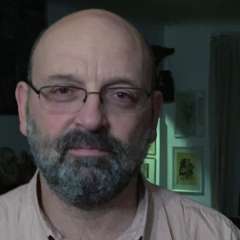Founded by Gabriela Carrizo and Franck Chartier two decades ago, the Belgian dance theatre company Peeping Tom has travelled the world with productions that, faithful to the ensemble’s name, have been peeking into the intricacies of individuals’ unconscious and the fabric of dysfunctional relationships. In order to express the portrayed characters’ innermost yearnings and anxieties, a steady team of interpreters has been using attention-grabbing gestures more than words. The public is constantly confronted with a world that looks and sounds familiar despite its extreme weirdness. Boundaries between real and surreal are always permeable.
Despite the Grand Théâtre de Genève’s new Dido and Aeneas being Chartier and Peeping Tom’s first operatic experience, music has always been an intrinsic element of the company’s Gesamtkunstwerks, constantly seeking the protection of a different muse besides Terpsichore. In 32, rue Vandenbranden (2009) a Chagallian character interpreted by one of the company’s pillars, mezzo Eurudike De Beul sings arias from a rooftop. In A Louer (2011), an operatic diva wanders through an overwhelming bourgeois environment struggling with her fears.
In this Geneva staging of Purcell's Dido and Aeneas, the action takes place in a wood-panelled room adorned with classical paintings, the elegant set designed by Justine Bougerol, the atemporal costumes by Anne-Catherine Kunz. “Didi” (De Beul), a former singer in her fifties, lies in a huge bed under a portrait of her deceased husband (directly inspired by Ingres’ Monsieur Bertin). She seems to have a nightmare and is fully covered by layers and layers of white sheets “unpeeled” by her arriving servants as if they attempt to reach her innermost thoughts. The story of Dido and Aeneas, as told, might just be the fruit of her imagination.
One soon realises that Chartier has split the opera’s few roles into dancing, speaking and singing parts. Didi’s singing alter-ego is called Elyssa, another name for the Queen of Carthage. She was interpreted with steady voice by Marie-Claude Chappuis, while baritone Jarrett Ott carefully shaped Aeneas’ “O solitude, my sweetest choice”. Hungarian soprano Emőke Baráth displayed a brilliant sound in her few interventions as Dido/Elyssa’s servant, Belinda. The two of them, plus soprano Marie Lys, also depicted the trio of envious sorceresses, ready to destroy Dido and Aeneas’ love. In a creepy sequence, Lys' head seemed to become detached from her body while the three were discussing their mischievous plan. The production might actually be remembered for its many surreal moments such as the never-ending flowing of tea in Aeneas’ cup or the stage slowly being “invaded” – as a sign of decay – by sand, first seeping from a plug in the wall, then through the windows, and finally pouring from the ceiling.
Towards the end, Chartier piles more tableaux vivants on top of each other, as if afraid he did not impress his public enough. The wall in the back opens, unveiling a hazy apocalyptic landscape (destroyed Troy?) from which a nude Aeneas (Portuguese dancer Romeu Runa) emerges covered in blood, carrying his son on his shoulders, with an axe in one hand and a flame thrower in the other. As Chappuis heartfully sings Dido's “When I Am Laid in Earth” lament, Didi is disrobed, and her body is washed as a corpse would have been by Belinda who vanishes afterwards into a hole in the wall (Elissa is swallowed up by the sands). Finally, while the chorus sings the elated “You Cupids come, to scatter roses on her tomb” from the balustrade on top of the room, one realises that the squirming pair of dancers present on the stage for a while, might actually represent one of Acteon’s dogs eating his transfigured master (a story actually mentioned in the opera’s second act). How can one focus on the music?
In a production marked by many levels of splits, those in the pit were even more dichotomic than the ones on stage. Purcell’s musical flux, interpreted with a felicitous combination of firmness and delicacy by Le Concert d’Astrée conducted by Emmanuelle Haïm, was constantly interrupted by contemporary sounding interludes composed and conducted by Atsushi Sakaï, a member of the ensemble and Haïm’s frequent collaborator. His eerie meanderings were mostly associated with the phantasmagorical images pouring from Didi’s mind. The composer also took his cello to the stage, occasionally being scolded by De Beul's character: “What is this contemporary crap music? Stop it Sakaï!” or, later, “Get some rhythm!” These modern insertions were not without poetic character, but the two musical streams never gelled together on any level, and one could easily get frustrated by the inability to just listen to Purcell’s divine melodies.
A staging that bombards and overwhelms the audience with myriad details – many quite enticing – does not really provide a new perspective on Purcell’s opera. Franck and his team of funambulist dancers could simply have employed a contemporary score to tell his version of the famous story from Virgil’s Aeneid.
This performance was reviewed from the Grand Théâtre de Genève video stream




